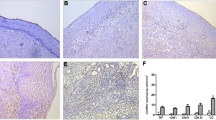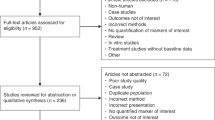Abstract
Only a small proportion of women infected with Human Papillomavirus (HPV) develop cervical cancer. Host immune response seems to play a role eliminating the viral infection and preventing progression to cancer. Characterization of tumor infiltrating lymphocytes (TILs) in cervical pre-neoplastic lesions and cervical cancer may be helpful to understand the mechanisms that mediate this protection. The aim of this study was to determine if there are differences in the localization and density (cells/mm2) of CD8+ T-cells, CD4+ T-cells and Tregs (CD25 + Foxp3+) in cervical pre-neoplastic lesions and cervical cancer. Immunohistochemical analysis of sections of 96 (26 CIN1, 21 CIN2, 25 CIN3, and 24 SCC) samples revealed that regardless of CIN grades, CD8+ T-cells are more abundant than CD4+, CD25+ and Foxp3+ cells in both the stroma and epithelium. There was a higher density of CD8+ cells in the stroma of cervical cancer compared to CIN3 (OR = 4.20, 95% CI 1.2-15), CIN2 (OR = 7.86, 95% CI 1.7-36.4) and CIN1 (OR = 4.25, 95% CI 1.1-17). Studies evaluating whether these cells are recruited before or after cancer progression will be helpful to understand the role of these cells in the natural history of HPV-induced lesions.
Similar content being viewed by others
Abbreviations
- HPV:
-
Human Papillomavirus
- SCC:
-
Squamous cell carcinomas
- IC:
-
Invasive Carcinoma
- CIS:
-
Carcinoma in situ
- CIN1:
-
Cervical Intraepithelial Neoplasia 1
- CIN2:
-
Cervical Intraepithelial Neoplasia 2
- CIN3:
-
Cervical Intraepithelial Neoplasia 3
References
Ferlay J, Shin HR, Bray F, Forman D, Mathers C, Parkin DM (2010) Estimates of worldwide burden of cancer in 2008: GLOBOCAN 2008. Int J Canc 127:2893–2917
Walboomers JM, Jacobs MV, Manos MM, Bosch FX, Kummer JA, Shah KV, Snijders PJ, Peto J, Meijer CJ, Munoz N (1999) Human papillomavirus is a necessary cause of invasive cervical cancer worldwide. J Pathol 189:12–19
Muñoz N, Castellsague X, de Gonzalez AB, Gissmann L (2006) Chapter 1: HPV in the etiology of human cancer. Vaccine 24S3:S1–S10
Syrjanen K, Hakama M, Saarikoski S, Vayrynen M, Yliskoski M, Syrjanen S, Kataja V, Castren O (1990) Prevalence, incidence, and estimated life-time risk of cervical human papillomavirus infections in a nonselected Finnish female population. Sex Transm Dis 17:15–19
Winer RL, Hughes JP, Feng Q, Xi LF, Cherne S, O'Reilly S, Kiviat NB, Koutsky LA (2011) Early natural history of incident, type-specific human papillomavirus infections in newly sexually active young women. Canc Epidemiol Biomarkers Prev 20:699–707
Rodriguez AC, Schiffman M, Herrero R, Wacholder S, Hildesheim A, Castle PE, Solomon D, Burk R (2008) Rapid clearance of human papillomavirus and implications for clinical focus on persistent infections. J Natl Canc Inst 100:513–517
Franco E, Villa L, Sobrinho J, Prado J, Rosseau M, Desy M, Rohan T (1999) Epidemiology of the adquisition and clearance of cervical human papillomavirus infection en women from a higth-risk area for cervical cancer. J Infect Dis 180:1415–1423
Rodriguez AC, Schiffman M, Herrero R, Hildesheim A, Bratti C, Sherman ME, Solomon D, Guillen D, Alfaro M, Morales J, Hutchinson M, Katki H et al (2010) Longitudinal study of human papillomavirus persistence and cervical intraepithelial neoplasia grade 2/3: critical role of duration of infection. J Natl Canc Inst 102:315–324
Trottier H, Mahmud SM, Lindsay L, Jenkins D, Quint W, Wieting SL, Schuind A, Franco EL (2009) Persistence of an incident human papillomavirus infection and timing of cervical lesions in previously unexposed young women. Canc Epidemiol Biomarkers Prev 18:854–862
Castle PE, Rodriguez AC, Burk RD, Herrero R, Wacholder S, Alfaro M, Morales J, Guillen D, Sherman ME, Solomon D, Schiffman M (2009) Short term persistence of human papillomavirus and risk of cervical precancer and cancer: population based cohort study. BMJ 339:b2569
Khan MJ, Castle PE, Lorincz AT, Wacholder S, Sherman M, Scott DR, Rush BB, Glass AG, Schiffman M (2005) The elevated 10-year risk of cervical precancer and cancer in women with human papillomavirus (HPV) type 16 or 18 and the possible utility of type-specific HPV testing in clinical practice. J Natl Canc Inst 97:1072–1079
Moscicki AB, Schiffman M, Kjaer S, Villa LL (2006) Chapter 5: updating the natural history of HPV and anogenital cancer. Vaccine 24 Suppl 3:S3-42-51
Ostor AG (1993) Natural history of cervical intraepithelial neoplasia: a critical review. Int J Gynecol Pathol 12:186–192
Woo YL, Sterling J, Damay I, Coleman N, Crawford R, van der Burg SH, Stanley M (2008) Characterising the local immune responses in cervical intraepithelial neoplasia: a cross-sectional and longitudinal analysis. BJOG 115:1616–1622
Monnier-Benoit S, Mauny F, Riethmuller D, Guerrini JS, Capilna M, Felix S, Seilles E, Mougin C, Pretet JL (2006) Immunohistochemical analysis of CD4+ and CD8+ T-cell subsets in high risk human papillomavirus-associated pre-malignant and malignant lesions of the uterine cervix. Gynecol Oncol 102:22–31
Bell MC, Edwards RP, Partridge EE, Kuykendall K, Conner W, Gore H, Turbat-Herrara E, Crowley-Nowick PA (1995) CD8+ T lymphocytes are recruited to neoplastic cervix. J Clin Immunol 15:130–136
Yamazawa K, Matsui H, Ishikura H, Seki K, Mitsuhashi A, Sekiya S (2003) Significance of perivascular lymphocytic infiltrates on survival of patients with invasive cervical cancer. J Immunother 26:149–155
Tay SK, Jenkins D, Maddox P, Singer A (1987) Lymphocyte phenotypes in cervical intraepithelial neoplasia and human papillomavirus infection. Br J Obstet Gynaecol 94:16–21
Piersma SJ, Jordanova ES, van Poelgeest MI, Kwappenberg KM, van der Hulst JM, Drijfhout JW, Melief CJ, Kenter GG, Fleuren GJ, Offringa R, van der Burg SH (2007) High number of intraepithelial CD8+ tumor-infiltrating lymphocytes is associated with the absence of lymph node metastases in patients with large early-stage cervical cancer. Cancer Res 67:354–361
Nedergaard BS, Ladekarl M, Thomsen HF, Nyengaard JR, Nielsen K (2007) Low density of CD3+, CD4+ and CD8+ cells is associated with increased risk of relapse in squamous cell cervical cancer. Br J Cancer 97:1135–1138
van den Brule AJ, Pol R, Fransen-Daalmeijer N, Schouls LM, Meijer CJ, Snijders PJ (2002) GP5+/6+ PCR followed by reverse line blot analysis enables rapid and high-throughput identification of human papillomavirus genotypes. J Clin Microbiol 40:779–787
Baay MF, Quint WG, Koudstaal J, Hollema H, Duk JM, Burger MP et al (1996) Comprehensive study of several general and type-specific primer pairs for detection of human papillomavirus DNA by PCR in paraffin-embedded cervical carcinomas. J Clin Microbiol 34:745–747
Fleiss J, Levin B, Paik M (2003) Statistical methods for rates and proportions. Wiley, New York
Schwartz GJ, Munoz A, Schneider MF, Mak RH, Kaskel F, Warady BA, Furth SL (2009) New equations to estimate GFR in children with CKD. J Am Soc Nephrol 20:629–637
Stanley M (2010) HPV: immune response to infection and vaccination. Infect Agent Canc 5:19
Sautès-Fridman C, Cherfils-Vicini J, Damotte D, Fisson S, Fridman WH, Cremer I, Dieu-Nosjean MC (2011) Tumor microenvironment is multifaceted. Cancer Metastasis Rev 30:13–25
Ismail SM, Colclough AB, Dinnen JS, Eakins D, Evans DM, Gradwell E, O'Sullivan JP, Summerell JM, Newcombe RG (1989) Observer variation in histopathological diagnosis and grading of cervical intraepithelial neoplasia. BMJ 298:707–710
Biggerstaff J, Weidow B, Amirkhosravi A, Francis JL (2006) Enumeration of leukocyte infiltration in solid tumors by confocal laser scanning microscopy. BMC Immunol 7:16
Carreon JD, Sherman ME, Guillén D, Solomon D, Herrero R, Jerónimo J, Wacholder S, Rodríguez AC, Morales J, Hutchinson M, Burk RD, Schiffman M (2007) CIN2 is a much less reproducible and less valid diagnosis than CIN3: results from a histological review of population-based cervical samples. Int J Gynecol Pathol 26:441–446
Trimble CL, Clark RA, Thoburn C, Hanson NC, Tassello J, Frosina D, Kos F, Teague J, Jiang Y, Barat NC, Jungbluth AA (2010) Human papillomavirus 16-associated cervical intraepithelial neoplasia in humans excludes CD8 T cells from dysplastic epithelium. J Immunol 185:7107–7114
Adurthi S, Krishna S, Mukherjee G, Bafna UD, Devi U, Jayshree RS (2008) Regulatory T cells in a spectrum of HPV-induced cervical lesions: cervicitis, cervical intraepithelial neoplasia and squamous cell carcinoma. Am J Reprod Immunol 60:55–65
de Vos van Steenwijk PJ, Heusinkveld M, Ramwadhdoebe TH, Lowik MJ, van der Hulst JM, Goedemans R, Piersma SJ, Kenter GG, van der Burg SH (2010) An unexpectedly large polyclonal repertoire of HPV-specific T cells is poised for action in patients with cervical cancer. Cancer Res 70:2707–2717
Zehbe I, Kaufmann AM, Schmidt M, Hohn H, Maeurer MJ (2007) Human papillomavirus 16 E6-specific CD45RA + CCR7+ high avidity CD8+ T cells fail to control tumor growth despite interferon-gamma production in patients with cervical cancer. J Immunother 30:523–532
Cheriyan VT, Krishna SM, Kumar A, Jayaprakash PG, Balaram P (2009) Signaling defects and functional impairment in T-cells from cervical cancer patients. Cancer Biother Radiopharm 24:667–673
Battaglia A, Buzzonetti A, Baranello C, Ferrandina G, Martinelli E, Fanfani F, Scambia G, Fattorossi A (2009) Metastatic tumour cells favour the generation of a tolerogenic milieu in tumour draining lymph node in patients with early cervical cancer. Canc Immunol Immunother 58:1363–1373
Wu MY, Kuo TY, Ho HN (2011) Tumor-infiltrating lymphocytes contain a higher proportion of FOXP3(+) T lymphocytes in cervical cancer. J Formos Med Assoc 110:580–586
Mizuki M, Tagawa S, Machii T, Shibano M, Tatsumi E, Tsubaki K, Tako H, Yokohama A, Satou S, Nojima J, Hirota T, Kitani T (1998) Phenotypical heterogeneity of CD4 + CD8+ double-positive chronic T lymphoid leukemia. Leukemia 12:499–504
Acknowledgements
Astrid M. Bedoya is a recipient of a doctoral fellowship from Colciencias 2007. We also are grateful to Graciela Torres for her technical assistance, Dr German Osorio from Pathology Department of University of Antioquia and Fundación Valle del Lili and Dr. Alvaro Muñoz for his help on the statistical analysis. This study is funded by CODI–CPT 0914 Asociación de polimorfismos de genes de la respuesta inmune con cáncer cervical en la población de Antioquia. This study was part of a collaboration thru the Red Iberoamericana para la investigacion y prevencion del Cancer de cuello uterino financed by CYTED (CANCERVIX, Code P210RT0286)
Conflict of Interest
The authors declare that they have no conflict of interest.
Author information
Authors and Affiliations
Corresponding author
Rights and permissions
About this article
Cite this article
Bedoya, A.M., Jaramillo, R., Baena, A. et al. Location and Density of Immune Cells in Precursor Lesions and Cervical Cancer. Cancer Microenvironment 6, 69–77 (2013). https://doi.org/10.1007/s12307-012-0097-8
Received:
Accepted:
Published:
Issue Date:
DOI: https://doi.org/10.1007/s12307-012-0097-8




